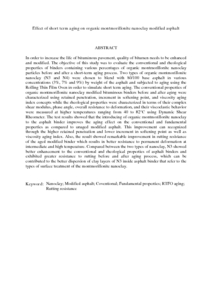Citation
Mahdi, Lamya M. J. and Muniandy, Ratnasamy and Yunus, Robiah and Hasham, Salihudin and Aburkaba, Eltaher
(2013)
Effect of short term aging on organic montmorillonite nanoclay modified asphalt.
Indian Journal of Science and Technology, 6 (11).
pp. 5434-5442.
ISSN 0974-6846; ESSN: 0974-5645
Abstract
In order to increase the life of bituminous pavement, quality of bitumen needs to be enhanced and modified. The objective of this study was to evaluate the conventional and rheological properties of binders containing various percentages of organic montmorillonite nanoclay particles before and after a short-term aging process. Two types of organic montmorillonite nanoclay (N3 and N4) were chosen to blend with 80/100 base asphalt in various concentrations (3%, 7% and 9%) by weight of the asphalt and subjected to aging using the Rolling Thin Film Oven in order to simulate short term aging. The conventional properties of organic montmorillonite nanoclay modified bituminous binders before and after aging were characterized using retained penetration, increment in softening point, and viscosity aging index concepts while the rheological properties were characterized in terms of their complex shear modulus, phase angle, overall resistance to deformation, and their viscoelastic behavior were measured at higher temperatures ranging from 40 to 82°C using Dynamic Shear Rheometer. The test results showed that the introducing of organic montmorillonite nanoclay to the asphalt binder improves the aging effect on the conventional and fundamental properties as compared to unaged modified asphalt. This improvement can recognized through the higher retained penetration and lower increment in softening point as well as viscosity aging index. Also, the result showed remarkable improvement in rutting resistance of the aged modified binder which results in better resistance to permanent deformation at intermediate and high temperature. Compared between the two types of nanoclay, N3 showed better enhancement to the conventional and rheological properties of asphalt binders and exhibited greater resistance to rutting before and after aging process, which can be contributed to the better dispersion of clay layers of N3 inside asphalt binder that refer to the types of surface treatment of the montmorillonite nanoclay.
Download File
![[img]](http://psasir.upm.edu.my/28701/1.hassmallThumbnailVersion/Effect%20of%20short%20term%20aging%20on%20organic%20montmorillonite%20nanoclay%20modified%20asphalt.pdf)  Preview |
|
PDF (Abstract)
Effect of short term aging on organic montmorillonite nanoclay modified asphalt.pdf
Download (84kB)
| Preview
|
|
Additional Metadata
Actions (login required)
 |
View Item |

